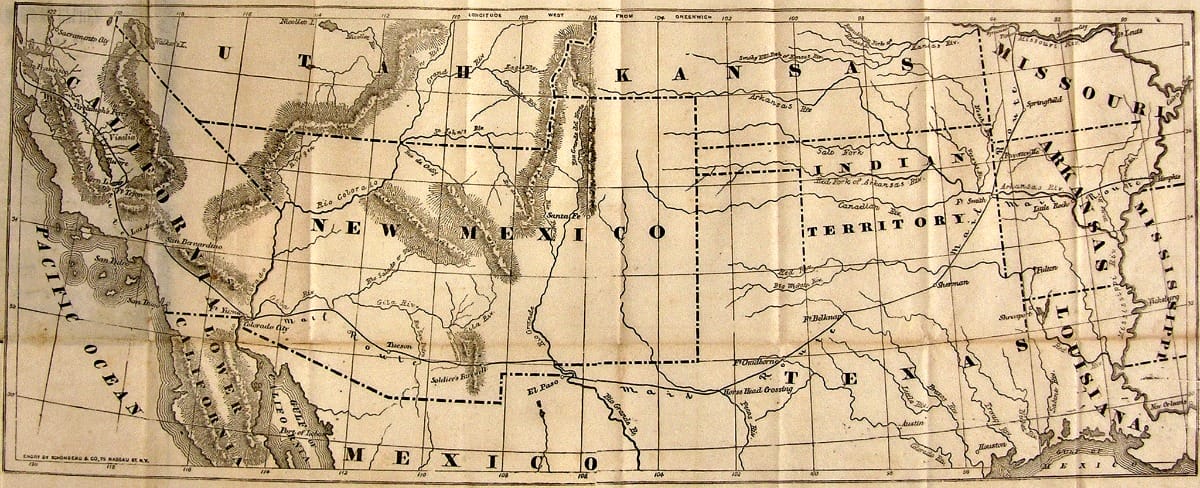

Uh oh...
It appears that you're using a severely outdated version of Safari on Windows. Many features won't work correctly, and functionality can't be guaranteed. Please try viewing this website in Edge, Mozilla, Chrome, or another modern browser. Sorry for any inconvenience this may have caused!
Read More about this safari issue.

Though not the official motto of the U.S. Postal service, these words have long been associated with the timely delivery of mail across the U.S. When Arkansas was still a young state, the Postal Service was trying to devise a new route to carry the mail from coast to coast. The Butterfield Trail, a route that crisscrosses Arkansas, was born out of this necessity.
Neither snow nor rain nor heat nor gloom of night stays these couriers from the swift completion of their appointed rounds.”
Mail delivery from St. Louis to San Francisco prior to 1858 was often by ship. Congress approved the idea of a land mail route in 1857 and the Postmaster General, former Tennessee Governor Aaron Brown, chose to give the overland stage contract to John Butterfield. Butterfield proposed a southern route that began in Tipton, Missouri and meandered south through Arkansas to Ft. Smith, with a branch to Memphis and Little Rock, before heading west across Indian Territory.

Establishing a route across Arkansas, Indian Territory, Texas, New Mexico, Arizona and California presented several problems. Roads had to be connected and bridges built. Fortunately, from Missouri through Arkansas, roads already existed to accommodate the stagecoach service.
The first stagecoach journey on the Butterfield Overland Trail began on September 16, 1858. The stagecoach left Missouri and traveled down through Arkansas, stopping at way stations Butterfield arranged to provide rest stops, food, lodging and fresh horses. From the Missouri line to Ft. Smith, the trail stopped at seven way stations.
Callahan’s Tavern, near Rogers, was already a popular stop for stagecoach travelers before the Butterfield mail route was established. At the inn, weary travelers could expect a hot meal, fresh water and other amenities. Other stops along the Butterfield Trail included Fitzgerald’s Station in Springdale, a Fayetteville station run by Butterfield’s son, Park’s Station in Hogeye, Brodie’s Station near Lee Creek, Woolsey’s Station at Signal Hill and a station in Van Buren.

The arrival of a stagecoach was always greeted enthusiastically since they brought mail and passengers with news from other parts of the country. The first Butterfield stagecoach arrived in Ft. Smith on September 19th at 2:00 am to the cheers of a large crowd. The first stagecoach from the Memphis route had arrived just fifteen minutes prior to the St. Louis line.
Travel by stagecoach in Arkansas wasn’t easy. The terrain south of Fayetteville was so rugged, Butterfield had his drivers switch to mules and a hardier stagecoach. Newspaperman Waterman L. Ormsby rode the very first stage from Missouri all the way to San Francisco. When the stage reached Arkansas, he wrote in his book, The Butterfield Overland Mail:
“I had thought before we reached this point that the rough roads of Missouri and Arkansas could not be equaled; but, here Arkansas fairly beats itself. I might say our road was steep, rugged, jagged, rough and mountainous – and then wish for some more expressive words…”

Photo Credit: National Archives photo no. 111-SC-89096
The trip from Memphis to Ft. Smith, where the two sections of the Butterfield Trail converged in Arkansas, was no easier. Originally passengers and mail were scheduled to travel by steamboat from Memphis to Ft. Smith, but low water levels in 1858 forced Butterfield to hire out an existing Arkansas stagecoach line. Passengers occasionally had to travel by foot as the stage searched for ferry crossings, hit swampy Arkansas land and navigated rough roads. Stagecoach stops along the way included Madison, Des Arc, Plumer’s Station (Plummerville), Potts Inn, Dardanelle, Stinnett’s Station and Paris, among others. The Potts home is still intact and is now the Potts Inn Museum.
The Butterfield Overland Stage ran through Arkansas from 1858 to 1861. By March of 1861, mail and passenger service began taking a more northerly route in anticipation of the Civil War. The use of the telegraph and railroad also cut down on the need for stage service.
Today the Butterfield Trail still exists in portions of Arkansas. Those interested in driving it and viewing the scenery stage passengers would have seen can follow the map on arkansasheritagetrails.com. The route between Ft. Smith and Missouri winds through Van Buren, Cedarville, Devil’s Den, Hogeye, Fayetteville, Springdale and Rogers via Highway 71 and Old Wire Road. Old Wire Road was both a telegraph line and part of the Butterfield Trail. If you’re traveling along this route, stop in at Elkhorn Tavern in Pea Ridge National Military Park. The tavern was an unofficial stop on the Butterfield Trail.

If you’re driving the Memphis to Ft. Smith trail, you can travel either the original route from Memphis, or take the spur that passed through Conway and Little Rock. Be sure to visit the Potts Inn Museum to see one of the original trail stations.
Those who prefer to hit the Butterfield Trail on foot can do so at Devil’s Den State Park. The park has a hiking trail called the Butterfield Trail in honor of the stagecoach line. The fifteen-mile trail puts you at eye level with some of the steep terrain that mules and stagecoaches had to navigate traveling from Fayetteville to Ft. Smith. The hiking trail actually follows part of the original stagecoach trail as well as Lee Creek. As you enjoy the magnificent bluffs, hardwood forests and rocky paths, be thankful you’re not crossing the rough trail in a bouncing coach on its way from Missouri to California!
Join the Conversation
Leave a Comment
3 responses to “The Butterfield Overland Trail Delivered Arkansas”
 Leave a Reply
Leave a Reply
We do the work.
You check your email.
Sign up for our weekly e-news.
Get stories sent straight to your inbox!












 Leave a Reply
Leave a Reply
[…] Kirkbride Potts in the early 1800s, the inn is one of the best-preserved stagecoach stations on the Butterfield Overland mail route between Memphis and Fort Smith. The Inn, along with multiple outbuildings including […]
[…] as Phillips Landing, this town established on the higher ground became the main street for wagons, stagecoach routes and trains. The town’s growth hinged on being the hub of commerce and connection in Western […]
[…] town flourished due to steamboat traffic from New Orleans. It served as a crucial stop along the Butterfield Overland Mail and Stagecoach route while developing its expanding mercantile center and transportation hub. During the Civil War, […]